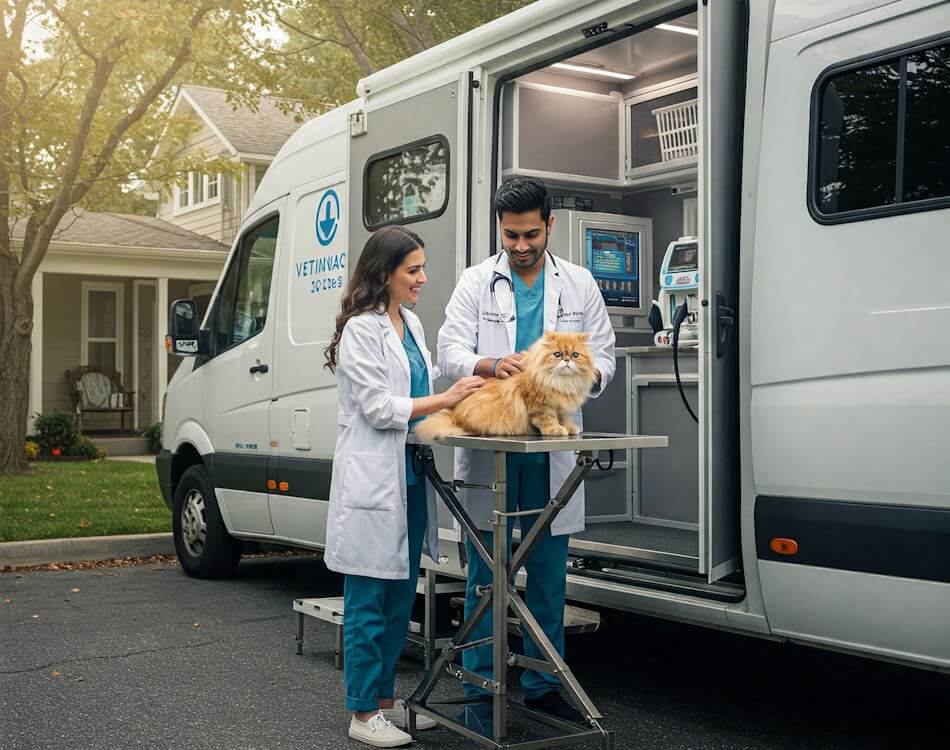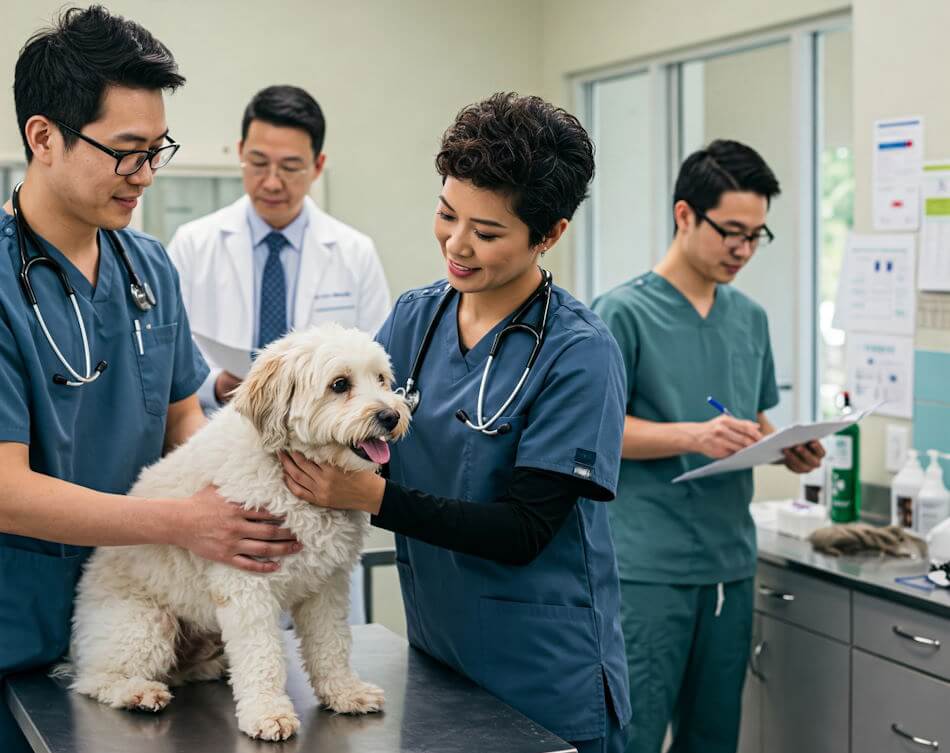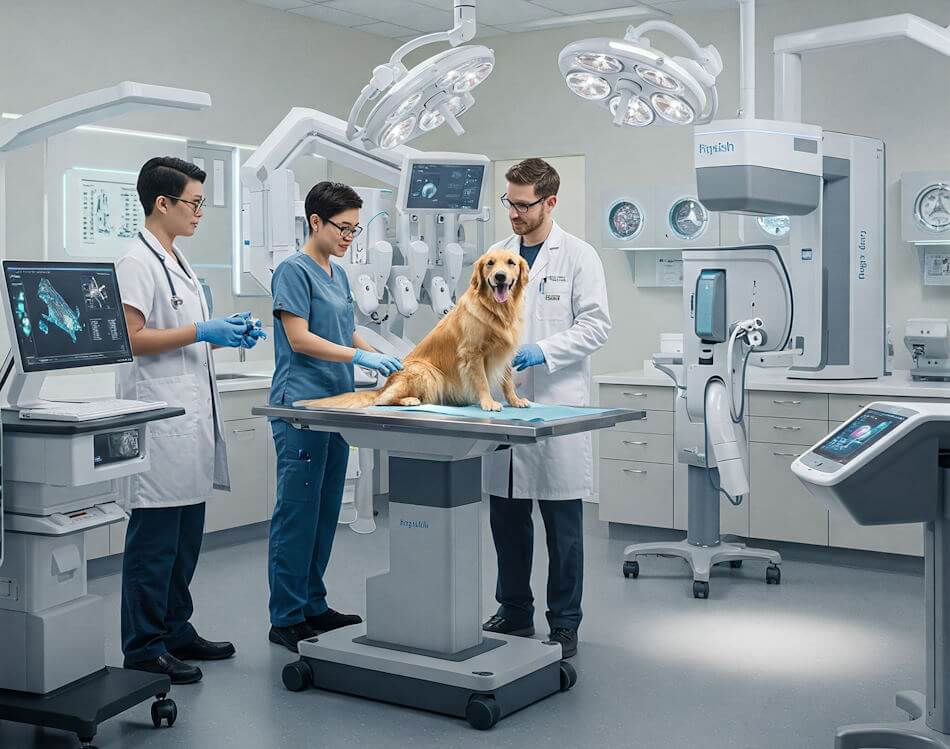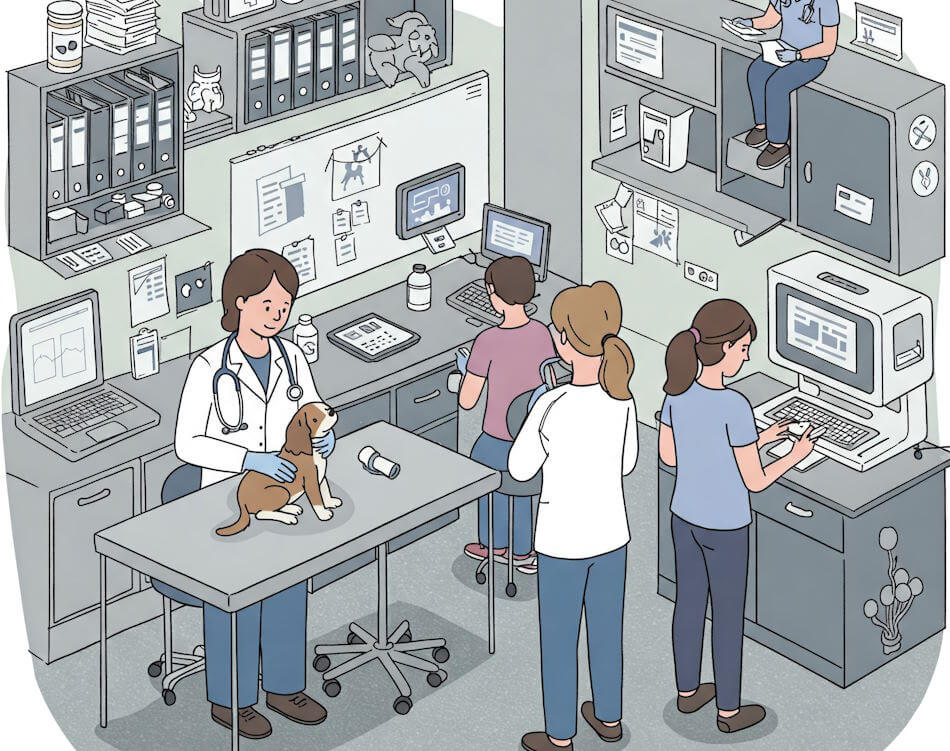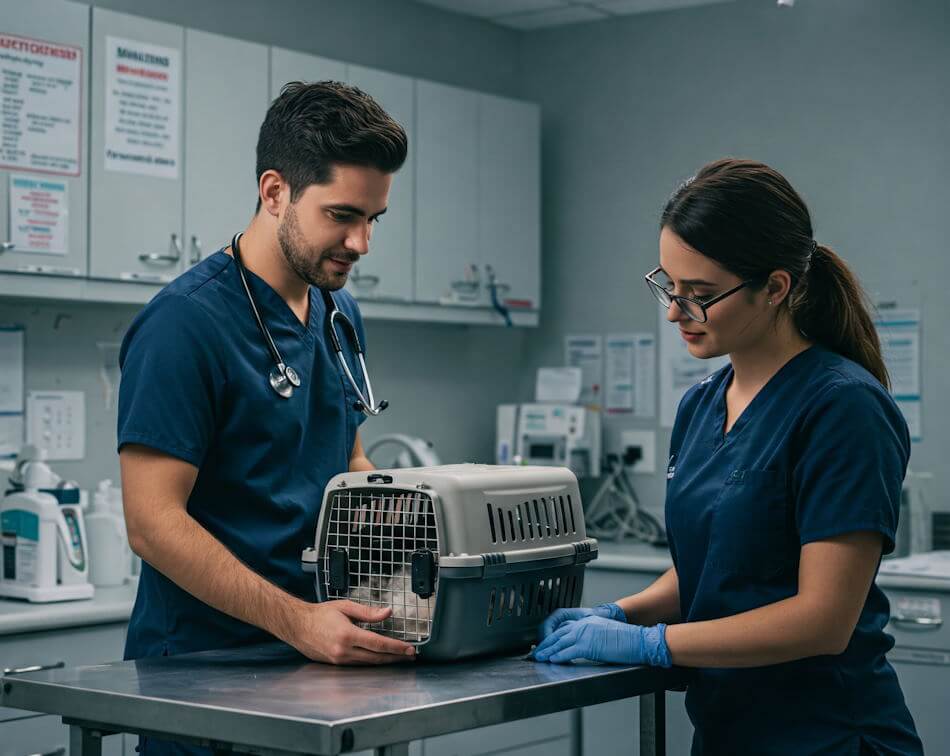Mobile veterinary services represent a significant evolution in the way veterinary care is delivered to pets and their owners. Unlike traditional veterinary practices, which typically require pet owners to transport their animals to a physical clinic, mobile veterinary services bring the clinic directly to the pet’s home. This innovative approach is not only convenient but has also gained traction in response to the growing demands of pet owners who seek personalized and accessible care for their furry companions.
At the core of mobile veterinary services is the commitment to providing high-quality care in a familiar and comfortable environment for pets. This unique model allows veterinarians to conduct routine check-ups, vaccinations, and even more complex procedures right in the home of the pet owner. The mobile vet’s vehicle is equipped with the necessary medical tools and technologies to perform a range of services, thereby eliminating the stress that many pets experience during transportation and at formal veterinary settings.
The rise of mobile veterinary services reflects broader trends in consumer behavior, where convenience and service personalization are increasingly prioritized. Pet owners appreciate the ability to schedule appointments that fit their busy lifestyles and the added benefit of receiving care in an environment where their pets feel safe. Additionally, this model allows for a more in-depth consultation, as veterinarians can observe pets in their natural surroundings, which can provide valuable insights into their health and behavior.
Overall, mobile veterinary services are transforming the veterinary landscape by introducing a more flexible and user-friendly approach to pet healthcare. As the demand for such services continues to grow, it will be intriguing to see how this model further influences the industry, potentially setting new standards for pet care delivery and enhancing the overall welfare of animals.
The Rise of Mobile Veterinary Practices
The emergence of mobile veterinary services marks a significant shift in the veterinary industry, fueled by various factors that align with changing consumer behaviors, advancements in technology, and unforeseen global events. One of the primary catalysts for this trend is the evolving expectations of pet owners. As lifestyles become increasingly hectic, pet owners seek convenience akin to other service sectors. The option of receiving veterinary care in the comfort of one’s own home enhances the overall experience for both pets and their owners, reducing stress and travel time associated with traditional veterinary visits.
Moreover, technological advancements have played a pivotal role in the rise of mobile veterinary practices. With the advent of telemedicine and digital health records, veterinarians can provide exceptional care remotely, allowing for earlier diagnosis and treatment. Mobile practitioners are equipped with high-quality diagnostic tools, enabling them to conduct comprehensive examinations on-site. This seamless integration of technology not only enhances the quality of care but also increases efficiency, allowing veterinarians to cater to a larger number of clients in a single day.
The COVID-19 pandemic further accelerated the adoption of mobile veterinary services. Lockdowns and social distancing measures led pet owners to reconsider traditional veterinary visits, heightening their awareness of alternative care options. Mobile services emerged as a safe solution, allowing pet owners to maintain access to necessary veterinary care while adhering to health guidelines. This change in dynamics has instilled a greater trust in mobile practices, as evidenced by the growing number of pet owners prioritizing these services well beyond the pandemic. Thus, the rise of mobile veterinary practices not only reflects a response to immediate needs but also signifies a long-term evolution in how pet care is perceived and delivered.
Benefits for Pet Owners
Mobile veterinary services are revolutionizing the way pet owners access healthcare for their animals. One of the primary advantages is the immense convenience these services offer. Pet owners can schedule appointments that suit their busy lives, allowing for greater flexibility as veterinarians travel directly to their homes. This reduces the need for time-consuming trips to a veterinary clinic, which can often involve lengthy waiting periods and potentially stressful environments for pets.
Another significant benefit is the reduced stress experienced by pets. For many animals, visits to a clinic can be overwhelming due to unfamiliar noises, smells, and other animals. Mobile veterinary services help mitigate this anxiety by providing a calm, familiar environment where pets feel safe. In a setting they know well, pets are less likely to exhibit fearful behaviors, enabling veterinarians to conduct examinations and treatments more effectively. Numerous pet owners have reported that their pets are more relaxed and cooperative during in-home visits, which enhances the overall experience for both the pet and its owner.
Personalized care is yet another compelling advantage of mobile veterinary services. Veterinarians can take the time to focus on individual pets without the distractions and pressures of a busy clinic. This allows for tailored treatment plans and comprehensive evaluations, resulting in enhanced health outcomes for pets. For instance, a mobile veterinarian may notice specific behavioral traits or physical signs that owners might overlook during a typical clinic visit, ensuring a more complete understanding of a pet’s needs. Testimonials from satisfied pet owners consistently highlight the unique aspects of personalized service as a key reason for choosing mobile vets.
In conclusion, the convenience, reduced stress levels for pets, and personalized care provided by mobile veterinary services illustrate a transformative shift in the veterinary field, aligning with pet owners’ evolving expectations and needs.
Benefits for Veterinarians
The advent of mobile veterinary services has introduced numerous advantages for veterinarians, fundamentally transforming their practice dynamics. One of the most significant benefits is the reduction in overhead costs. Traditional veterinary clinics require substantial investment in physical space, utilities, and maintenance. In contrast, mobile practices operate from a vehicle equipped with essential medical supplies and equipment, leading to decreased financial burdens. This cost efficiency allows veterinarians to allocate resources toward enhancing the quality of care and expanding their service offerings.
Moreover, mobile veterinary services facilitate the development of stronger relationships between veterinarians and their clients. By providing care directly in the clients’ homes, veterinarians can foster a more personal connection with pet owners, making it easier to understand their concerns and needs. This personalized approach can encourage open communication and trust, leading to improved client satisfaction and loyalty. Such strong relationships not only enhance the client experience but also promote consistent follow-ups and better compliance with treatment plans.
Another notable advantage of mobile veterinary practices is the potential for a better work-life balance. Veterinarians often face demanding schedules, which can lead to burnout and job dissatisfaction. Mobile services allow for a more flexible work environment, as veterinarians can manage their appointments in a way that fits their personal schedules. This flexibility contributes to improved overall job satisfaction, as practitioners can maintain a healthier equilibrium between their professional and personal lives.
Additionally, providing veterinary care in familiar and comfortable settings for pets and their owners can lead to increased satisfaction for veterinarians. Being able to witness the comfort and ease that pets experience in their own homes can be professionally rewarding. This added dimension of care makes mobile veterinary services not just a business model, but a fulfilling practice that enhances veterinary professionals’ experiences and job satisfaction.
Challenges Faced by Mobile Veterinary Services
Mobile veterinary services are revolutionizing the animal healthcare industry, yet they encounter a variety of challenges that can hinder their effectiveness. One significant hurdle is logistical issues, which encompass scheduling appointments, managing travel routes, and ensuring timely availability of services. Unlike traditional clinics that have a fixed location, mobile veterinarians must navigate diverse terrains and traffic conditions, making it crucial for them to optimize their travel plans. The variability in customer demand adds another layer of complexity, as peak times can lead to overwhelming workloads while off-peak times may result in underutilization of resources.
Regulatory hurdles represent another major challenge faced by mobile veterinary services. Regulations can vary considerably by state or region, impacting how services are delivered. Many regions have specific licensing requirements for mobile operations, which may necessitate additional certifications or insurance. Furthermore, adherence to local health regulations regarding the transport of medical waste and pharmaceuticals can complicate operations, forcing veterinarians to remain perpetually informed about the changing legal landscape.
The necessity for specialized equipment cannot be understated. Mobile veterinarians must equip their vehicles with diagnostic tools, surgical instruments, and treatment facilities to deliver comprehensive care on-the-go. This equipment not only requires significant financial investment but also demands regular maintenance and updates, which can strain operational budgets. Additionally, the limited space in mobile units poses constraints on the extent of services that can be offered, as operators must prioritize equipment based on the types of procedures most commonly required in their service areas.
Regional variations also play a critical role in shaping the challenges mobile veterinary services face. In urban environments, high demand may necessitate larger teams and more sophisticated scheduling software, while rural areas might struggle with limited connectivity and population density. As practitioners continue to innovate solutions, understanding these challenges can help pave the way for improved services in the mobile veterinary landscape.
Technology’s Role in Mobile Veterinary Services
In recent years, advancements in technology have significantly contributed to the growth and efficiency of mobile veterinary services. The integration of telemedicine into veterinary care allows veterinarians to connect with pet owners remotely, providing consultations and advice without the need for an in-person visit. This practice not only increases accessibility for clients but also enhances convenience, particularly for those in remote areas or for clients with pets that may be anxious during travel. Telemedicine supports prompt decision-making and enables veterinarians to assess the condition of animals before scheduling an in-home visit, thereby optimizing resources.
Additionally, digital appointment scheduling plays a crucial role in the operations of mobile veterinary services. This technology simplifies the booking process for clients, allowing them to select convenient times for veterinary visits directly through user-friendly interfaces. The automation of appointment reminders reduces the likelihood of missed appointments and can lead to more frequent care for pets. Such efficiency is paramount in a mobile setting where time management is essential, allowing veterinarians to serve more clients and extend their outreach in the community.
Moreover, the utilization of electronic health records (EHR) in mobile veterinary practices allows for streamlined management of patient information. EHR systems enable veterinarians to access and update medical histories and health records on-the-go, promoting better continuity of care. The integration of this technology not only improves the accuracy of health data but also facilitates real-time information sharing among veterinary professionals, which is especially beneficial during emergency situations. By harnessing technology, mobile veterinary services enhance the overall customer experience, streamline operations, and ultimately contribute to the better health and welfare of pets.
Case Studies of Successful Mobile Veterinary Services
As the demand for mobile veterinary services continues to rise, several enterprises have emerged, setting benchmarks for success in this burgeoning field. Through innovative approaches and client-centered solutions, these individuals have redefined pet care delivery. One notable example is “Paw on Wheels,” a mobile veterinary service based in San Francisco that has successfully integrated telemedicine into their practice. By offering virtual consultations alongside traditional in-home visits, this service accommodates pet owners who may have scheduling conflicts or prefer remote interactions. As Dr. Emily Thompson, the veterinarian behind Paw on Wheels, stated, “We aim to make veterinary care as accessible as possible, especially for pet owners juggling busy lifestyles.”
Another compelling case is “Vet on the Go,” operating in the metropolitan areas of New York and New Jersey. This service has excelled by emphasizing convenience and flexibility. They utilize an online booking system that allows pet owners to select specific times for appointments, significantly reducing wait times and ensuring a personalized experience. Dr. Richard Lopez, the founder, highlighted the importance of adaptability in this competitive market: “Our goal is to meet our clients where they are – financially and geographically – and to provide the same level of care they would receive in traditional clinics.”
Moreover, “The Happy Paws Mobile Veterinary Clinic” in Chicago has notably focused on chronic care management for pets with specific health concerns. They offer a comprehensive plan that includes regular check-ups, medication management, and dietary guidance directly at the pet owner’s home. According to Dr. Linda Chen, “The convenience of receiving veterinary care at home significantly helps manage the health of pets suffering from chronic illnesses.” This tailored approach not only solidifies client loyalty but also enhances the overall health outcomes for pets.
Through these examples, it becomes evident that successful mobile veterinary services are characterized by their adaptability, innovation, and commitment to client satisfaction, contributing to their ability to thrive amid industry challenges.
The Future of Mobile Veterinary Services
The landscape of veterinary care is undergoing significant transformation, primarily driven by the rise of mobile veterinary services. As pet ownership continues to grow, the demand for convenient and accessible care is reshaping the industry. Predictions indicate that mobile veterinary services will become increasingly integral to pet healthcare. This paradigm shift is not merely a response to consumer preferences but is also influenced by ongoing advancements in technology and medical practices.
Technological innovations such as telemedicine are expected to play a crucial role in the evolution of mobile veterinary services. As veterinarians harness the power of video consultations and remote diagnostics, they can provide timely advice and identify health issues from the comfort of a pet owner’s home. Moreover, the development of portable diagnostic tools will allow veterinarians to perform comprehensive examinations on-site, thereby expanding the scope of care offered during mobile visits.
In addition to technological improvements, the future of mobile veterinary services will likely see an emphasis on preventative care. As pet owners become more educated about their pets’ health needs, there will be a push for services that focus on wellness rather than just reactive measures. Mobile veterinary teams will be positioned to provide routine check-ups, vaccinations, and nutritional counseling directly to clients, thus promoting a more proactive approach to pet health.
Furthermore, as mobile veterinary care continues to expand, traditional veterinary practices may need to adapt to this evolving environment. Clinics might pivot towards specialized services or unique offerings that differ from those available in mobile settings. Ultimately, the widespread adoption of mobile veterinary services could foster collaboration between traditional and mobile practices, enhancing overall care accessibility and quality.
As we look to the future, it is evident that mobile veterinary services will not only persist but will also redefine the pet healthcare landscape. The interplay between technology, preventive care, and changing consumer behaviors will likely drive continuous improvement and innovation within the industry.
Conclusion
The emergence of mobile veterinary services represents a significant shift within the veterinary industry. These services are not merely an extension of traditional veterinary practices; instead, they disrupt conventional norms by providing a unique and flexible approach to pet care. As highlighted throughout this blog post, the convenience and accessibility offered by mobile veterinary practices have proven to enhance the overall experience for both pet owners and their pets. By bringing care directly to the pet’s home, mobile veterinarians eliminate the stress often associated with transporting pets to clinics, particularly those that may have anxiety or special needs.
The impact of mobile veterinary services extends beyond mere convenience. These services often facilitate a more personalized approach to pet care, allowing veterinarians the opportunity to observe pets in their home environment. This can lead to better assessments and more tailored treatment plans, ultimately enhancing the quality of care provided. Additionally, the reduction in overhead costs associated with a traditional clinic situation may enable mobile practices to offer competitive pricing, thereby increasing access to veterinary care for wider populations.
Furthermore, mobile veterinary services encourage a shift in how veterinary professionals engage with their community. The emphasis on preventive care and client education fosters stronger relationships between pet owners and veterinarians. As these services gain traction, they not only meet the demands of modern pet ownership but also adapt to the fast-paced lifestyles of pet owners. Considering the numerous advantages of mobile veterinary services, it becomes evident that they will play a vital role in redefining the landscape of veterinary care in the future. Pet owners and professionals alike are encouraged to embrace these transformative services for the benefit of their practices, pets, and the industry as a whole.

